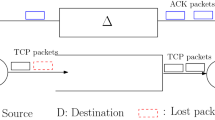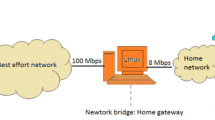Abstract
We present a novel shaping algorithm, called effective bandwidth shaper (EBS), which limits passing data streams' effective bandwidths to a pre-defined upper bound. The shaping algorithm is part of the proposed traffic engineering approach for providing quality of service guarantees to the network users. The traffic engineering approach relies on the property, that effective bandwidths do not change when passing a network node, the so called “invariance property” of effective bandwidths. The algorithm's functionality is verified by application to MPEG video traces. Furthermore, the shaping performance is investigated in different network scenarios with reactive TCP traffic. Our performance studies focus on the dependencies of delays and throughputs upon the number of competing connections, the choice of the space parameter, different TCP protocol variants, and buffer sizes. Moreover we show that the effective bandwidths' invariance when passing a switch, as proven for the case of the many limiting regime (infinitely many sources), holds already for a surprisingly small number of competing flows even in the presence of aggressive TCP traffic.
Similar content being viewed by others
References
T. Bonald, A. Proutière and J.W. Roberts, Statistical performance guarantees for streaming flows using expedited forwarding, in: Proc. of IEEE INFOCOM 2001, Anchorage, Alaska, USA (2001).
O. Bonaventure and S. De Cnodder, Request for comments: 2963, RFC 2963, category: informational (2000).
C.-S. Chang and J.A. Thomas, Effective bandwidth in high speed digital networks, IEEE Journal on Selected Areas in Communications 13(6) (1995) 1091–1100.
N.G. Duffield, J.T. Lewis, N. O'Conell, R. Russell and F. Toomey, Entropy of ATM streams: A tool for estimating QoS parameters, IEEE Journal on Selected Areas in Communications 13(6) (1995) 981–990.
R.J. Gibbens, Traffic characterisation and effective bandwidths for broadband network traces, Statistical Laboratory Research Report 1996–9, University of Cambridge (1996).
F.P. Kelly, Notes on effective bandwidths, in: Stochastic Networks: Theory and Applications, eds. F. Kelly, S. Zachary and I. Zeidins, (Oxford Univ. Press, Oxford, 1996) pp. 141–168.
G. Kesidis, J. Walrand and C.-S. Chang, Effective bandwidths for multiclass Markov fluids and other ATM sources, IEEE Transactions on Networking 1(4) (1993) 424–428.
K. Lindberger, Dimensioning and design methods for integrated ATMnetworks, in: Proc. of Internat. Teletraffic Congress - ITC 14 (Elsevier Science, Amsterdam, 1994).
L. Massoulié, Large deviations ordering of point processes in some queueing networks, Queueing Systems (1999).
MPEG4: Movie trace files, Technical University Berlin, Germany, http://www-tkn.ee.tu-berlin. de/research/trace/ltvt.html.
I. Stoica, S. Shenker and H. Zhang, Core-stateless fair queueing: Achieving approximately fair band-width allocations in high speed networks, in: Proc. of SIGCOMM'98, Vancouver, Canada (1998) pp. 118–130.
S. Tartarelli, M. Falkner, M. Devetsikiotis, I. Lambadaris and S. Giordano, Empirical effective band-widths, in: Proc. of IEEE GLOBECOM 2000, Vol. 1 (2000) pp. 672–678.
The Almagest, Vols. I, II, III: Ptolemy Users Manual, Programmers Manual, Kernel Manual (Univ. of California, Berkeley, 1997); http://ptolemy.eecs.berkeley.edu/ptolemyclassic/ almagest/user.htm, http://ptolemy.eecs.berkeley.edu/ptolemyclassic/almagest/prog.htm, http://ptolemy.eecs.berkeley.edu/ ptolemyclassic/almagest/kern.htm.
D. Wischik, The output of a switch, or, effective bandwidths for networks, Queueing Systems 32 (1999) 383–396.
J. Yang and M. Devetsikiotis, On-line estimation, network design and performance analysis, in: Proc. of Internat. Teletraffic Congress - ITC 17 (Elsevier Science, Amsterdam, 2001).
Author information
Authors and Affiliations
Rights and permissions
About this article
Cite this article
Abendroth, D., Killat, U. An Advanced Traffic Engineering Approach Based on the Approximate Invariance of Effective Bandwidths. Telecommunication Systems 27, 393–411 (2004). https://doi.org/10.1023/B:TELS.0000041017.61322.59
Issue Date:
DOI: https://doi.org/10.1023/B:TELS.0000041017.61322.59




